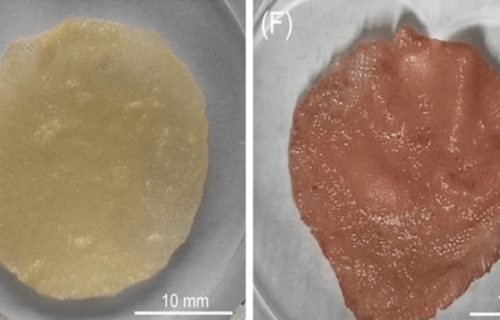SUZHOU, China — Lab-grown, or cultured, meats represent a promising, more environmentally friendly alternative to actual meat from livestock, but high production costs have hindered its widespread use. Now, however, research out of Singapore and China reports the discovery of a way to use food waste to make cultured meat, which would reduce production costs considerably.
Cultured meat is made using animal muscle stem cells grown on a scaffold, which improves the environment for the cells by enabling transport of nutrients and allowing for the generation of texture and structure. Without this approach, the meat is more likely to end up resembling lumpy mashed potatoes.
Unique scaffolds can be created using an emerging 3D-printing technology known as Electrohydrodynamic (EHD) printing. These scaffolds become part of the meat product, so they have to be edible themselves, and are thus usually made using animal products such as gelatin and collagen, or synthetic materials. This is expensive to produce. Establishing a more affordable way to create edible inks for printing would be a major boon for the cultured meat movement.
Discarded cereal could create cheaper meat substitutes
In this latest study, researchers developed edible plant-based ink derived from food waste, such as cereal husks. The new ink is capable of being fully absorbed into meat products and is cheap to produce, meaning it can potentially significantly reduce the cost of large-scale cultured meat production.
“We have optimized our plant-based ink for 3D-printing technology so that we can print scaffolds and place muscle stem cells on them. The cells can then grow with the structure of the scaffold and we use beets to color the grown meat to give it the look of conventional meat,” says study author Professor Jie Sun from Xi’an Jiaotong-Liverpool University, China in a media release.
Professor Sun, along with researchers from the National University of Singapore Suzhou Research Institute and the National University of Singapore mixed cereal proteins extracted from barley or rye with corn protein (zein) to create pure cereal protein-based inks for the first time ever.
“This is a novel and disruptive idea to mass produce cultured meat. Using nutrients from food waste to print scaffolds not only uses and increases the value of the food waste but also alleviates the pressure on the environment from animal agriculture,” Prof. Sun adds.
Why are the requirements for creating meat scaffolds different from other cells?
“When culturing cancer cells for drug research, we want them to gather into clusters to mimic how they grow in the human body. Thus, we have high requirements for the strength of the scaffold, which has to be strong enough to support the cell clusters,” Prof. Sun explains.
“However, when cultivating meat, we want the meat to grow evenly so it can have a better texture for eating,” she continues. “Therefore, we do not need a scaffold with high tensile strength. Instead, we want it to be edible and absorbed by muscle cells.”
“These are some of the biggest challenges in finding an edible ink suitable for EHD printing of the scaffolds. We tested various materials and finally decided to use plant protein to make scaffolds,” the researcher says.
Moving forward, researchers hope plant extracts will also be used to create the nutrient-rich substance the meat cells grow in.
“Currently, one of the major reasons for the high cost of cultured meat is the nutrient medium for muscle cells, which is still from animal proteins. In the future, if suitable plant extracts can be found to supply nutrients, that will further reduce the cost of cultured meat, making it more affordable,” Prof. Sun concludes.
The study is published in the journal Advanced Materials.

